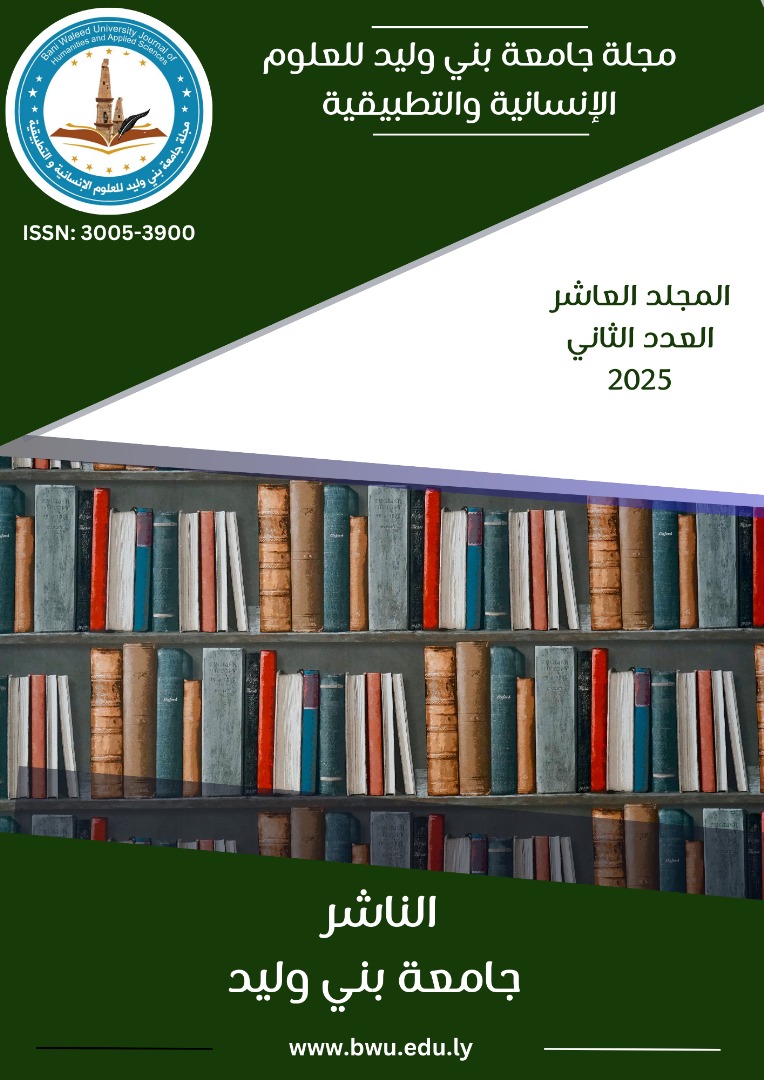Analysis of the Twin Deficits in Light of the Monetary and Financial Variables in the Libyan Economy During the Period (1990-2022) " An Econometric study "
DOI:
https://doi.org/10.58916/jhas.v10i2.725Keywords:
current account deficit, budget deficit, Twin Deficit, ARDL, Libya.Abstract
This study discusses the relationship among current account deficit, budget deficit in light monetary and financial variables in the Libyan economy during the period (1990-2022) using the (Bounds test) and ARDL model to estimate the long-run and short-run relationship between study variables in long-run and short-run. The results showed that there is a co-integration relationship between the study variables in the long-run, and that the current account deficit is positively affected by budget deficit, and negatively by both the foreign exchange rate and government spending, while the effect of trade openness was not statistically significant. The results also showed that there was a unidirectional causal relationship between the current account deficit and the budget deficit, going from the budget deficit to the current account deficit in the short-run, and that the causal relationship between them in the long-run was bidirectional.
Downloads
References
First: Arabic References:
- Al-Sawai, Khaled Mohammed, and Al-Azzam, Anwar Ahmed (2015), "Twin Deficits in Light of Monetary and Financial Variables, Economic Growth, and Trade Openness: The Case of Jordan during the Period (1975-2010)", Jordanian Journal of Economic Sciences, Jordan, Issue 2, Volume 2, pp. 97-114.
- Hassanein, Khaled Abdel Hamid (2002), "Twin Deficits - An Analytical Study of the Egyptian Case for the Period (1975-2020)", Journal of the Faculty of Economics and Political Science, Cairo University, Egypt, Issue 2, Volume 23, pp. 35-60.
- Moussaoui, Warda (2016), "Analysis of the Relationship between Budget Deficit and External Balance in the Algerian Economy for the Period (1990-2010)", Journal of Economics and Development, Yahya Fares University, Algeria, Issue 6, pp. 218-228.
- Abd Rabbo, Nashwa Muhammad (2019), "Twin Deficits: A Case Study of Egypt for the Period (1975-2018)", The Scientific Journal of Commerce and Finance, Tanta University, Egypt, Issue 2, Volume 39, pp. 329-360.
- Shahib, Rasha Khaled, Farhan, Israa, and Muhammad, Shaima Fadl (2020), "Measuring the Relationship between Budget Deficit and Trade Balance (Twin Deficits) in Iraq for the Period (1980-2018) Using the Engel-Granger Methodology", Wasit Journal of Humanities, Iraq, Issue 45, Volume 16, pp. 413-446. - Daif, Ahmed, and Wael, Miloud (2020), "The Relationship between the Trade Balance Deficit and the Budget Deficit in Algeria (Testing the Twin Deficit Hypothesis): An Econometric Study for the Period (1990-2017)", Journal of the Institute of Economic Sciences, Algeria, Issue 2, Vol. 23, pp. 45-65.
- Dalab, Abu Bakr Khalifa, and Attia, Ali Mansour (2022), "The Internal and External Deficits and Their Impact on the Value of the Libyan Dinar During the Period (1980-2020): An Analytical Study", Journal of Economic Studies, Sirte, Issue 3, Vol. 5, pp. 118-134.
- Sawan, Ali Salim Ali (2023), "The Development of Macroeconomic Balance Indicators in the Libyan Economy During the Period 1990-2020", Journal of Economic and Political Sciences, Issue 2, Vol. 20, pp. 101-123.
- Al-Wahsh, Sabir Al-Mahdi Ali, (2012), "Determinants of Economic Growth in the Libyan Economy," Journal of Economics and Trade, Al-Zaytouna University, Libya, Issue 1, pp. 62-84.
- Nasif, Ali Al-Mahdi, (2016), "The General Budget Deficit and Treatment Policies in the Libyan Economy," Journal of Al-Zaytouna University, Libya, Issue 17, pp. 107-116.
- Naja, Ali Abdul-Wahab, (2016), "Estimating the Import Demand Function in the Maghreb Countries during the Period (1970-2010)," Journal of Development and Economic Policies, Arab Planning Institute, Kuwait, Volume 8, Issue 1, pp. 43-90. - Naja, Ali Abdel-Wahab, and Nasr, Sherine Adel Hassan (2021), "The Extent of Okun's Law in the Egyptian Economy during the Period (1990-2019)", Scientific Journal of the Faculty of Economics and Political Science, Alexandria University, Issue 11, Volume 6, pp. 11-54.
- Salami, Ahmed (2015), "The Causal Relationship between Government Spending and Economic Growth in Algeria: An Empirical Study of the Period 1970-2013", Economic and Administrative Research, Issue 17, pp. 49-74.
- Al-Dardir, Abdel-Hakim, and Mansour, Abdel-Basset (2023), "A Study of the Causal Relationship between Inflation and Money Supply in the Libyan Economy Using the Toda-Yamamoto Methodology", Sabha University Journal of Pure and Applied Sciences, Sabha, Issue 1, Volume 21, pp. 55-61. - Amin, Tamer (2018), "Testing the Toda-Yamamoto Causality between Budget Deficit and Trade Balance in Algeria for the Period (1990-2016)", Journal of Financial, Accounting and Administrative Studies, Algeria, Issue 9, pp. 252-266.
- World Bank, (2016), "Libya: Economic Prospects" MENA Economic Monitor Report: www.worldbank.org.
Second: Foreign References:
- Sanni, G. K., & et al., (2022), "Twin Deficits in Nigeria: Where Does the Exchange Rate Fit?" Economic and Financial Review, Central Bank of Nigeria, Vol. 60, No. 1, pp. 67-91.
- Fidrmuc, J., (2003). "The Feldstein-Horioka Puzzle and Twin Deficits in Selected Countries", Economics of Planning, Vol. 36, No. 2, pp. 1-1. 135-152.
- Alakbarov, N, & Sasmaz, M, U., (2020), “Analysis Of Twin Deficit Problem And Feldstein-Horioka Hypothesis: AN Empirical Investigation For OECD Countries”, International Journal of Management Economics and Business, Vol. 16, No. 3, pp. 494-512.
- Hussain, I., & et al., (2024), “A Dynamic Analysis of the Twin-Deficit Hypothesis: the Case of a Developing Country”, Asia-Pacific Financial Markets, No. 32, pp. 25-52.
- Senadza, B, & Aloryito, G, K., (2016), “The twin deficits hypothesis: Evidence from Ghana”, International Journal of Business and Economic Sciences Applied Research, Vol 9, No. 3, pp. 55-62.
- Faridi M. Z. & Akhtar M. H., (2013), “An Estimation of Money Demand Function in Pakistan: Bo-und Testing Approach to Coint-egration”, Pakistan Journal of So-cial Sciences (PJSS), Vol. 33, No. 1, pp. 11-24.
- Shahbaz M., Ahmad K. & Chaud-hary A. R., (2008), “Economic Growth and Its Determinants in Pak-istan”, The Pakistan Development Review, Vol. 47, No. 4, Part II, PP. 471–486, http://www.pide.org








